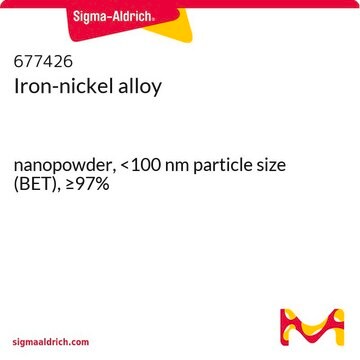208558
Zirconium(II) hydride
−325 mesh, 99%
Synonym(s):
Zirconium dihydride
About This Item
Recommended Products
Assay
99%
form
powder
reaction suitability
core: zirconium
reagent type: catalyst
reaction type: Reductions
reagent type: reductant
greener alternative product characteristics
Design for Energy Efficiency
Learn more about the Principles of Green Chemistry.
sustainability
Greener Alternative Product
particle size
−325 mesh
greener alternative category
, Enabling
SMILES string
[ZrH2]
InChI
1S/Zr.2H
InChI key
QSGNKXDSTRDWKA-UHFFFAOYSA-N
Looking for similar products? Visit Product Comparison Guide
General description
Application
- Reactive hot-pressing synthesis of Zr2SC ceramics
- Synthesis of Mg-TM hydrides for hydrogen storage
- Synthesis of nanocrystal ceramic composites by mechanical alloying
- Measurement of minimum ignition energies of dust clouds
- The oxidation of metal hydrides with molecular oxygen
- Reactive hot-pressing synthesis of Zr2SC ceramics by displacement reaction with the mixture of ZrC and ZrS2.,·
- The synthesis of Mg-Zr hydrides by treating with MgH2 for hydrogen storage.
- The preparation of layer structured β-zirconium nitride chloride (ZrNCl) by reacting with NH4Cl.
Analysis Note
Signal Word
Danger
Hazard Statements
Precautionary Statements
Hazard Classifications
Eye Irrit. 2 - Flam. Sol. 1 - Skin Irrit. 2 - STOT SE 3
Target Organs
Respiratory system
Storage Class Code
4.1B - Flammable solid hazardous materials
WGK
WGK 3
Flash Point(F)
Not applicable
Flash Point(C)
Not applicable
Personal Protective Equipment
Certificates of Analysis (COA)
Search for Certificates of Analysis (COA) by entering the products Lot/Batch Number. Lot and Batch Numbers can be found on a product’s label following the words ‘Lot’ or ‘Batch’.
Already Own This Product?
Find documentation for the products that you have recently purchased in the Document Library.
Our team of scientists has experience in all areas of research including Life Science, Material Science, Chemical Synthesis, Chromatography, Analytical and many others.
Contact Technical Service









